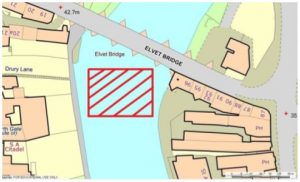May ’20
Toy Cannon
May’s ‘Object of the Month’ is a brass toy cannon from the River Wear Assemblage.
The Site

Between 2008 and 2019, archaeological investigations of a submerged river bed, positioned just downstream of the twelfth century Elvet Bridge in Durham City, County Durham, have revealed an important multi-period underwater archaeological site. This site has eventually yielded a significant collection of typically small metal finds, the total number of which now exceeds 13,000 objects.

The find site, positioned just downstream of the twelfth century Elvet Bridge in Durham City, lies mid-way between two areas of late-medieval urban development: the Borough of New Elvet and the Bishop’s Borough. The late-medieval city of Durham comprised of five boroughs, the tenements located in the Bishop’s Borough, positioned immediately to the west of the find site, were known as Saddlergate (now Saddler Street), while the tenements which abut the river to the east (in the Borough of New Elvet) were simply referred to as the western edge of New Elvet. (http://www.diveintodurham.uk/)
The Object

It is clear that the cannon is a muzzle-loader despite no surviving documentary evidence of the firing instructions which would have accompanied the toy cannon. The gun would have been loaded with black powder and shot (pistol shot, buck, birdshot or home-made projectiles), fitted with a slow match fuse made of saltpetre impregnated hemp, and touched off using a long stick. Quick match (gunpowder based) fuses or taper/heated wire fuses were also used. Modern calculations suggest that the toy cannon studied in this report could hold between 0.28-2.84g of black powder, therefore capable of a considerable projectile range.

X-radiography of the cannon showed no projectile lodged in the bore, however a lead weight might have been inserted in the breech, which would suggest that the cannon was fired during use. Lead was inserted in the breech to bring the charge and ball forwards, to reduce the amount of powder required to fire the cannon, and to improve the arc of trajectory of the cannon.
Most indicative of active use, are exploded barrels, symptomatic of a misfiring. Although the cannon studied in this report shows no such trace, another cannon deposited very close by, does. Evidently a group of associated objects, if one cannon was clearly being used as a firing toy, it would seem unlikely for the others to have an alternative method of use. It is therefore likely that this gun saw regular, yet successful use.

Egan’s and Forsyth’s ‘Toys, Trifles & Trinkets’ represents the sole comprehensive study of the ‘relatively neglected’ post-medieval base metal toys and miniatures. The study identifies twelve types of toy cannon all of which fall into one of two further classes, those intended for firing, and those intended for imaginative play. The cannon studied in this report is most synonymous with Type 3, a mass-produced toy cannon dating to the late 17th-early 18th century, of which there are several recorded examples. Evidence previously outlined indicates it was most likely used for active firing.

It is possible, but unlikely, that the cannon was a component of a ship model. Such objects were privately manufactured during the 17th century by master shipwrights, used solely for demonstrative and commemorative purposes, often presented to distinguished figures. At this time models remained highly specialist, rare and were certainly not mass-manufactured. Similarly, Mr. Allen Hunt is the earliest known commercial British model maker, yet he wasn’t active until the mid-18th century .

Often purchased at markets and fairs, toy cannons represent more than simply the exchange of goods, but a trinket of a time when the market place was crucial to the sharing of news, and the hub of the social lives of local people. Despite little record, it is likely that the appeal of a firing toy cannon also as a representation of the booming brass and strong gun founding industries, attracted both patriotic adult and child clientele.
Stay tuned for next month’s object!
